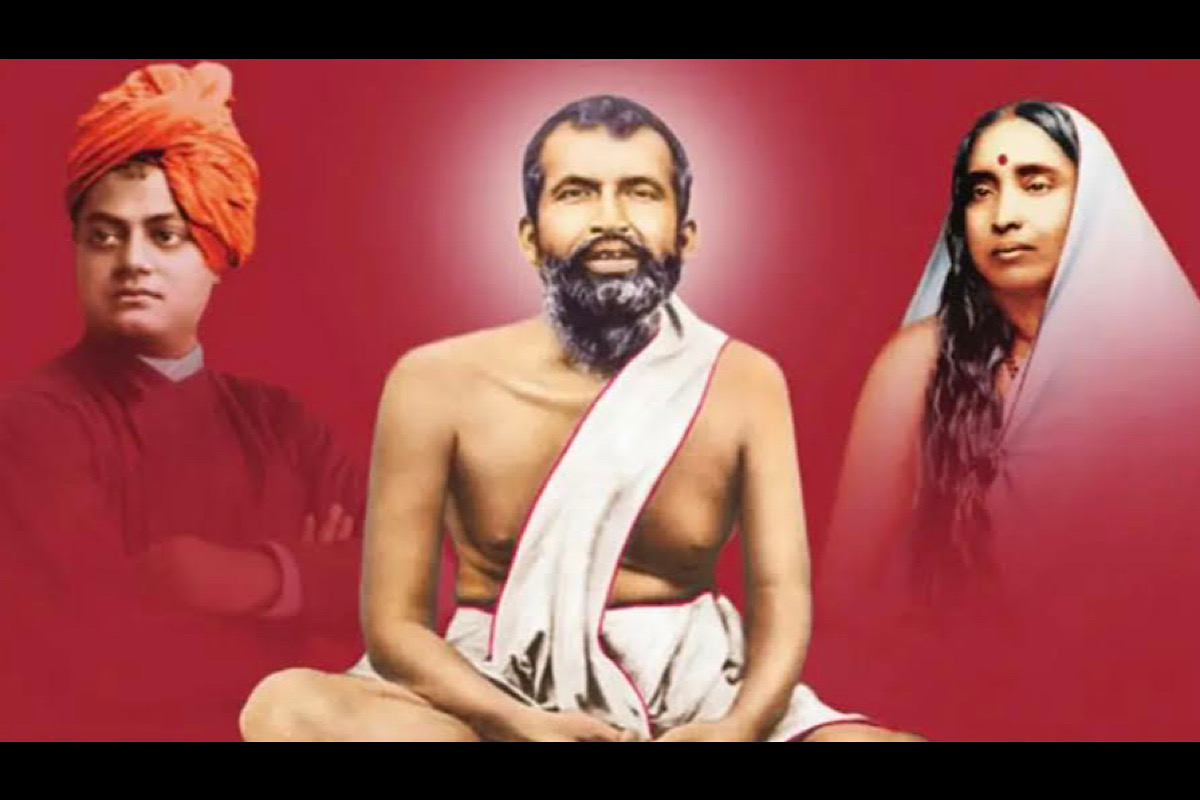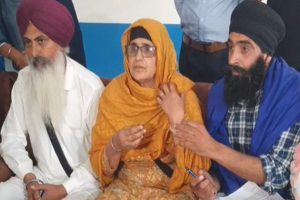Swamiji “found” his Master (Sri Ramakrishna) to say “that religion was a reality to be felt”, and he “actually saw that religion could be given.” He saw from his Master how practically “one touch, one glance can change a whole life”.
It needs no mention that he found this to happen in his own life itself. It was his direct experience indeed, which led him to firmly conclude: “Religion can be given and taken more tangibly, more really than anything else in the world.” He simultaneously “learned” from him “the beautiful truth that religions of the world are not contradictory or antagonistic. They are but various phases of one eternal religion.”
Equipped with this firsthand knowledge regarding religion, he further vitally concluded that religion was one, infinite and inclusive ~ there was no space for monopoly in it. Which is why, he unequivocally said: “Religion is the tie, unity of humanity.” Therefore, he had no qualms about urgently announcing: “Religion does not consist in believing any number of doctrines or dogmas, in going to churches or temples, in reading certain books.” He could tell that with absolute ease and earnestness, although he grew up amidst all such things, because he observed his Master hardly required them to realize religion in his life.
By dint of his realization, Sri Ramakrishna established himself as a living embodiment of religion and his spiritual consort Holy Mother Sarada Devi, having all the essence of religion embedded in her, was also evidently so. Hence, he proclaimed her to the world as non-different from him. Sarada Devi too had admittedly said the same subsequently to her devotees and disciples in confidence.
The truth that Sarada Devi was religion personified became perceptible to those who had the eyes to perceive the Divine in her. For example, Sister Devamata (Laura Glenn), an American nun came to India and lived with her for some time to have perceived Sarada Devi transmitting religion to her by “a word or touch”.
Devamata had beautifully narrated it in her book Days In An Indian Monastery: “Those who had the rare blessing of living with Holy Mother learned that religion was a natural, joyous thing; that purity and holiness were tangible realities; that the odour of sanctity was literally a sweet perfume overlaying and destroying the foulness of material selfishness. Compassion, devotion, Godunion were her very nature; one scarcely knew that she possessed them. It was through the soothing benediction of a word or touch that one sensed their presence.” The sterling divine and human qualities Devamata had seen in Holy Mother were like pearls inalienably adorned by Sarada Devi.
They were perpetually in display even to ordinary men and women who were poor, distressed and desolate. When religion eternal becomes one’s blood and flesh one is suffused with the love of God that knows no discriminations. This kind of “love opens the most impossible gates”. Sri Ramakrishna and Sarada Devi being its repositories incessantly radiated it and opened the impossible gates to numerous who were barred from religion and looked down upon as untouchables. They broke the adamantine walls of caste and community and gave access to their love freely.
Similarly, people cutting across class, culture and faith spontaneously rushed to them and were overwhelmed by their celestial affection. Its veracity was testified and documented by the reminiscences of the countless who came in their contact.
They had commonly said that an unqualified joy they felt in her proximity which they always remembered. Samadhi was perfectly in their grip. With the slightest intention they could climb up to its highest rung and experience Oneness of the Existence in an Absolute way. Therefore, socio-religious differences on the relative plane didn’t have any effect on their lives.
They were born to a particular faith and observed its customs but were not taken away by its doctrines and dogmas framed by its priests and pundits gratuitously. Their forte was the eternal love of the eternal religion, of which they were vibrant images. Accordingly, they were being adored and worshipped by people across the globe.
The hallmark of their personalities was their unassailable sense of non-attachment to the worldly enjoyments which make life messy and miserable. Thus, although very much in the world, they were, nevertheless, not of the world. They cried with the pains and laughed with the pleasures of worldly others but then they themselves were never carried away by pains and pleasures in their own lives. They showed that religion and renunciation were obverse and reverse of the same coin.
Yet, they were amazingly life accepting. In a word, they never flinched from any problems that were real in the household. They resided in intense rest in the midst of its intense activity, bridging a gap between the temporal and the spiritual. They exhibited how to remain at peace connecting oneself with God relentlessly, giving a turn to everything towards the Divine from the mundane. Their lives had charted a way forward to salvation, vindicating the truth that the goal of human life is to realize God. In the perspective of nondualistism, which may be deemed as the final word for religion, God is both the material cause and the efficient cause of the world at the same time.
He creates as well as sustains the world. “That One is manifesting Himself as many, as matter, spirit, mind, thought, and everything else.” By virtue of such characteristic God Himself is veritably the Religion (Dharma) itself, which is defined as the preserver (dharaka) of the world (jagat).
Since Religion and God are one, it is beginning-less and eternal. Non-dualistic ideal also tells us that one who realises God becomes God. Swamiji said: “Let the world resound with this (nondual) ideal, and let superstitions vanish.” He urged us to make the weak aware of it and tell them that they are not miserable, that they are pure and Divine. He also earnestly called them to manifest their real nature, in which they were all one. Sri Ramakrishna and Sarada Devi realized God and proved that they were God as well as Religion in one. They demonstrated how to differentiate between what is right and wrong in every moment of our lives, in every one of our actions, true and false.
Being an object lesson of The Religion and an epitome of truth, they showed us that the test of truth is purity, oneness. They taught us: “Everything that makes for oneness is truth.
Love is truth and hatred is false, because hatred makes for multiplicity. It is hatred that separates man from man; therefore, it is wrong and false. It is a distinguishing power; it separates and destroys. Love binds; love makes for that oneness.”
In Swamiji’s estimation, Sri Ramakrishna “had lived in one life the whole cycle of national religious existence in India.” Sarada Devi lived for thirtyfour years after Sri Ramakrishna’s departure, making his ideal practical in day to day life. She was tirelessly busy in worldly responsibilities, yet was remarkably sweet and calm as well as detached. She said: “We suffer as a result of our own actions; it is unfair to blame anybody for it. We have to surrender ourselves completely to the Lord with faith and devotion in Him, to serve others to the best of our capacity, and never be a source of sorrow to anybody.” As she had said, so she had done all through her life.
One of her monastic disciples and a long-time associate wrote to say that she severed the roots of all the inhibitions in social and domestic life in a smooth, simple and spontaneous manner. Removing the divisions between man and man, man and woman, religion and religion, monk and householder, spiritual practice and worldly activity, she pragmatically paved a way to their balanced and proportionate coexistence for a peaceful human society. So, if the soul of India is The Religion, as Swamiji had said repeatedly, Sri Ramakrishna and Holy Mother Sarada Devi were the Incarnations of that soul.
India could surely rise again sitting at their feet. By this it could alone integrally connect the Indian people in a sublime atmosphere of bonhomie, bailing it out of the contrived confusion it is now indulging in unnecessarily to its utter detriment
(The writer is associated with the Ramakrishna Mission Ashrama, Narendrapur)











